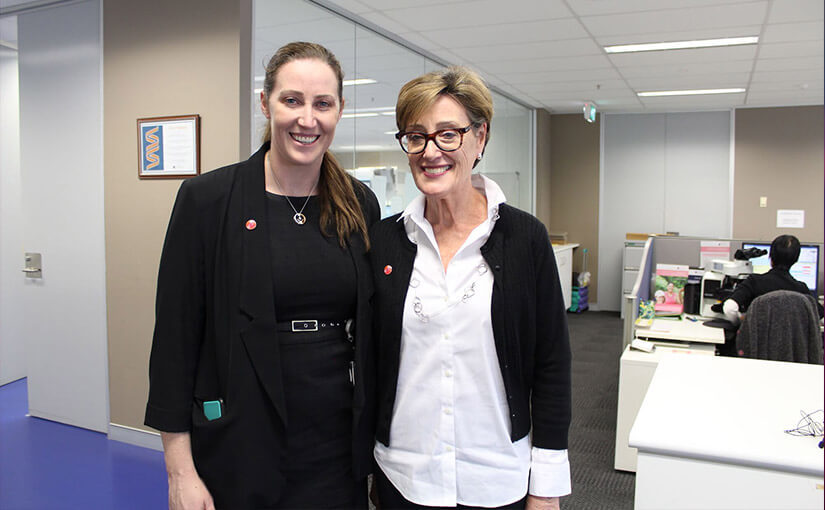New data reveals improved cervical cancer screening program is working but women still at risk
Olympic athlete and Commonwealth Games gold medallist Jana Pittman was diagnosed with a precancerous condition of the cervix whilst having IVF treatment in 2015. Pittman is now studying to become a doctor and wants to specialise in gynaecology.
Pittman visited a pathology laboratory to see how the Human Papilloma Virus (HPV) and cervical cancer are diagnosed. She is an advocate for women to participate in cervical screening, saying;
“I had put off getting tested for quite a few years, not because I didn’t want to be tested but because I was busy and hadn’t prioritised it. I want all women to take part in the screening program, it’s just five minutes and a bit of discomfort to get tested and get that peace of mind.”
More women should participate in the improved cervical cancer screening program to eliminate the disease. The latest data from the National Cervical Screening Program reveals that the new testing system introduced in December 2017 is working well but screening participation rates must increase.
The new test replaces the previous pap smear test – it is more sensitive and detects the the HPV which can cause changes in the cells of the cervix that may later lead to cancer.
The test is capable of detecting an HPV infection many years before a pap smear could find any changes in cells.
The HPV vaccine was introduced in Australia in 2007 and is now offered to teenage girls and boys as part of a school-based vaccination program to protect against strains of the virus that can cause genital warts and several types of cancer, including cervical cancer.
There are over 100 strains of HPV, with 15 strains known to be associated with cancer. The most recent vaccine protects against nine strains of HPV; seven of these can cause cancer and two are linked to genital warts.
The sample for pathology testing is collected in the same way as the previous pap test via a vaginal examination and cervical swab.
Data from the first six months of the new screening program found that a greater number of women were referred for colposcopy, a follow-up examination from an abnormal result, than with the previous pap smear testing system.
Estimates before the program began had predicted an increase in colposcopies, but the rate of referral was about three times higher than expected.
The study, published in Medical Journal Australia (MJA), analysed data from over 150,000 cervical screening samples received in the first six months of the new program.
Key findings were:
- Rates of any cancer-causing HPV were highest in women in the youngest age group of 25–29 years;
- Prevalence of the highest risk HPV types 16 and 18 peaked in the 30–34 age group;
- This age group had the highest number of women classified as ‘high risk’.
Adjunct Professor Annabelle Farnsworth is one of the paper’s authors and a leading expert in the field. She pointed out that many young women will not be aware they are still at risk of developing cervical cancer even though they have been vaccinated.
“The vaccine is very good, and we are lucky to have it in Australia. However, the early HPV vaccine only protected against four types of the virus, two of these are high-risk types. Even people who were vaccinated can still be at risk from other types of HPV. And of course, not all women have been vaccinated, which means it’s really important that every woman takes part in testing. If you have a negative result, you get peace of mind and you don’t need to be tested again for five years.”
According to the Australian Institute of Health and Welfare (AIHW) the participation rate for cervical screening in 2015–2016 was 56%.
A recent survey by the Australian Cervical Cancer Foundation (ACCF) looked at the reasons why women do not participate in screening. They found that over a quarter (26%) of women listed embarrassment and a third (32.3%) listed awkwardness as their reasons to avoid booking appointments for tests.
“Our national research demonstrates that whilst we, as a nation, have made significant gains when it comes to HPV vaccination rates and driving down new cases of cervical cancer, misunderstanding of cervical cancer and of the cervical screening test is rife. It’s imperative therefore that we not only act but react to the new research,” said Joe Tooma, CEO, ACCF.
Adj. Prof. Farnsworth said that women may be put off screening for a range of reasons. To support these women to take part in screening, a self-collect option is now available to eligible women under the new HPV testing system.
“Many women are not aware of the option for self-collection, meaning they can use a swab given by a health professional to collect their own sample in private whilst at the clinic. This may help women who would otherwise not be tested for all sorts of reasons, so we want to encourage women to talk to their GPs or health providers about this option,” said Adj. Prof. Farnsworth.
Adj. Prof. Farnsworth also wants women to be aware that this is a cancer that affects the young;
“HPV transmission typically starts when sexual activity begins and so a persistent infection may start to cause problems in 10–15 years when a woman is still young. The good news is that early detection leads to faster treatment of HPV, a precancerous condition or cancer itself. Women are often able to live a normal healthy life after treatment, including having children.”
According to a study in The Lancet medical journal, Australia is on track to eliminate cervical cancer by 2035. Australians (particularly those working in pathology) should be proud that we are so close to achieving this, however, to get there we must continue to strongly encourage participation in both vaccination programs and cervical screening tests.

